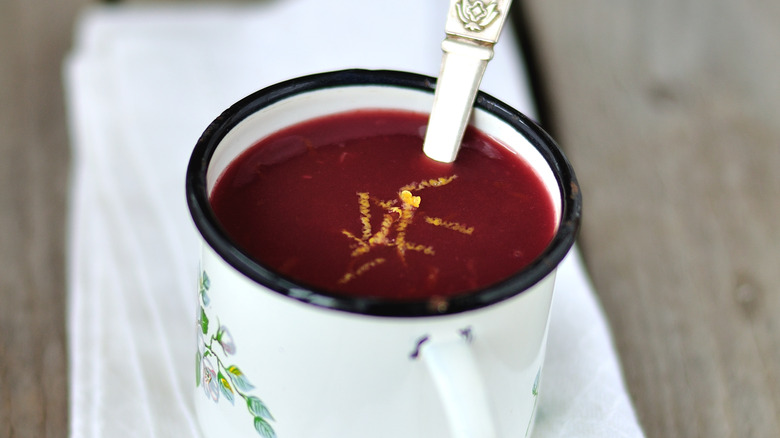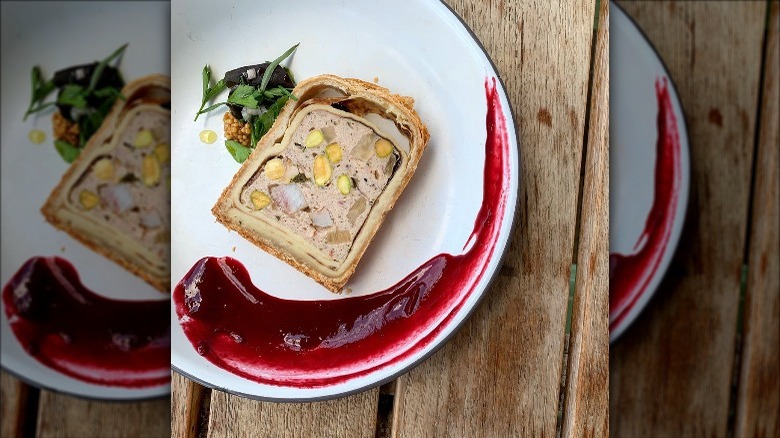Traditional British Cumberland Sauce Will Completely Elevate Cold Meat
While ketchup, mustard, and hot sauce are fairly universal, there are a select few condiments that are popular primarily in the U.K. Marmite, for example, is relatively hard to find in the U.S., but is a common spread for toast. Many Brits also enjoy something called bread sauce, which resembles white gravy, as well as an all-purpose sauce simply referred to as brown sauce. Salad cream is another popular accompaniment, though not nearly as versatile, as it's used mainly as a sandwich spread. There are plenty of others, including Cumberland sauce, a condiment that also goes by the name Oxford sauce.
Cumberland sauce is primarily flavored with red currants (either whole or in jelly form). It unfortunately isn't sold at most grocery stores in the U.S., except perhaps in shops selling goods that cater to British expats. Luckily, this condiment from across the pond is easy enough to make at home, and worth doing so, especially if you're looking for something new and tasty to flavor your cured meats or cold cuts with.
What is Cumberland sauce?
If you've never tried Cumberland sauce before, the taste and texture can best be compared to cranberry sauce. In fact, cranberry sauce is one ingredient you can use to make some in a pinch, though it's usually only included as a substitute for the red currants. Traditionally, the tartness of the fruit is elevated with orange and lemon, as well as port or red wine. Cumberland sauce is, therefore, a sweeter sauce, but it also has a bit of a kick, thanks to the addition of sharp mustard (dry powder or Dijon) and ground ginger. These punchy flavors are the key reason why this beloved British condiment works so well with cold meats, acting as a counterpoint to their richness.
There are many variations of Cumberland sauce, some of which also include more savory components like onion and garlic, as well as herbs like thyme and coriander. Non-alcoholic Cumberland sauce recipes also exist, in which the red wine or port is substituted for red wine vinegar instead. Store-bought Cumberland sauce tends to lean more sweet than savory, but whether you choose to make it from scratch or use the jarred kind, the condiment is always meant to be served cold.
Pairing Cumberland sauce with meat
Because of its distinct flavor, Cumberland sauce goes incredibly well with meat. Historically, it was used to mask the taste of certain strongly flavored meats, and to this day is still paired with venison, lamb, pork, and turkey, and used as a ham glaze. The use of Cumberland sauce also extends to cold cuts, most notably the ones you'd find on a charcuterie board. Unlike centuries ago, however, the reason for the pairing isn't so much to overtake the meat's potential gaminess, but rather to enhance the flavors.
On charcuterie boards, cold meats are often served alongside jams or marmalades that include many of the same ingredients that Cumberland sauce has. The fruitiness is there to balance out the saltiness of the meat, while the tartness cuts the fattiness. Savory jams like onion jam and pepper jam, meanwhile, produce an umami-like flavor profile when combined with meat. Cumberland sauce is the best of both worlds. It's fruity and sweet yet savory and sharp, making it the perfect condiment for cold cuts, cured meats, pâtés, terrines, and potted meats.


